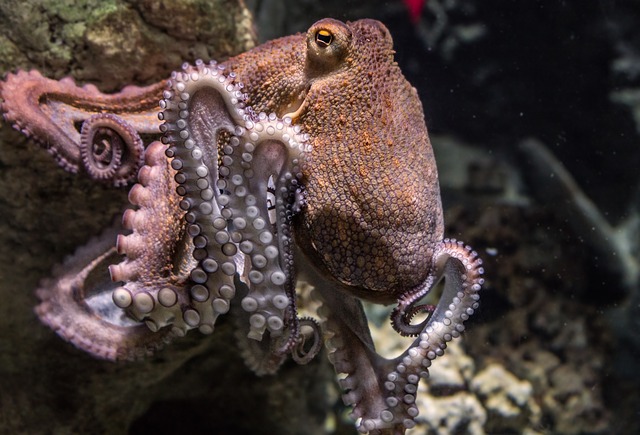Octopus Facts
Below are some of the facts about Octopus:
- The typical look of an Octopus, by which it can be easily recognized is a bulbous head and eight limbs. Octopuses live in oceans, and have a boneless soft body. They are molluscs.
- Being boneless, they can squeeze their body to pass through narrow openings. They squirt ink for protecting themselves from predators.
- Octopuses have blue colored blood, and have three hearts.
- There are 289 known species of Octopuses in the oceans.
- Many people refer to the limbs of octopuses as tentacles. But they are actually arms and are structured to hold on to things through the use of small suction cups lined in numbers below each arm. They use the arms to hunt their prey, find food, explore, hold on to surfaces etc.
- Octopuses are very intelligent. Quite interestingly their arms are individually functional, and each arm has a wit and mind of its own. That’s because of the bundles of neurons concentrated towards each arm.
- There are more nerve cells in the arms than in the head and body of the Octopus. That is why, while an octopus can find its route through a narrow cave or creak, while it’s another arm may concentrate on breaking open a shellfish for food.
- Some octopuses have warts and some have bumps all over their body. Identical species of octopuses can be distinguished on the basis of their warts and bumps.
- The sense of touch of octopuses is highly defined. They can touch a food with their limb, and through the sensory feel of the suction cups they can know the taste of the food item.
- There is no protective shell or bone cover or cartilage in it. But there is a hard beak like opening to the mouth of the Octopus, which stays guarded by the eight limbs. Besides this the jaw of the octopus is very powerful, and this organism has a toxic venomous saliva.
- There are three hearts in the body of an octopus. One heart pumps blood to the organs in its body. The other two heart are to supply blood to the gills of the octopus.
- The blood of octopus is blue colored because of hemocyanin. This is a copper based protein compound which transfers oxygen in the body, and acts identical to hemoglobin in the red blooded animals.
- The most common octopus is octopus vulgaris, which is 12 to 36 inches in length and weighs between 3 and 10 kg.
